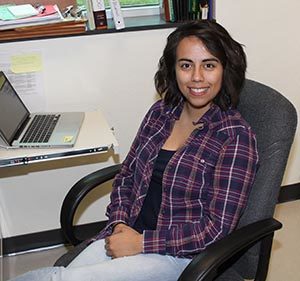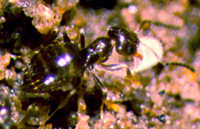Postdoctoral Research Associate

Elly Espinoza
I am an entomologist researching invasive ant species in the Department of Entomology at Texas A&M University. I am interested in learning more about the biology of ants, their social organization, and how they impact non-native environments. I hope to develop innovative ways to control invasive ants, to better manage their spreading populations and prevent the negative impacts they can have when introduced in a non-native habitat.
I am currently studying the dark rover ant (Brachymyrmex patagonicus) using microsatellites, essentially specific gene variations in individuals, to determine the population genetic structure of numerous colonies across the urban ecology of major cities in Texas. In addition, I am also developing our understanding of the life history of the dark rover ant, a neglected invasive species for which we know little about, in terms of, for example: colony structure, aggression, queen behavior, and rearing methods.

Rover Ant. Photo by Bart Drees
I received my doctorate in Entomology in May of 2017, under the supervision of Dr. Roger Gold and Dr. Jeffery Tomberlin at Texas A&M University. As a doctoral student, I explored the microbial interactions of the invasive red imported fire ant, designing experiments to survey the bacterial community of the fire ant colony and the impact of particular bacteria on fire ant behavior. I generated and analyzed 16S rRNA bacterial marker gene data using the Illumina MiSeq sequencing platform to identify and compare the bacterial communities of fire ants across colony functional category (e.g. castes, developmental stage, midden), ecoregion, and colony. In other projects, I studied fire ant interactions with Proteus mirabilis bacteria, observing the foraging and nestmate interactions of ants when exposed to bacteria-treated baits or inoculated soil environments.
I am interested in studying microbe-insect host interactions, exploring microbes as commensal and pathogenic species impacting the pressures of insect populations in non-native habitats. Investigating patterns of genetic variation via population genetics, insect populations can be differentiated to account for the evolutionary consequences of habitat changes and phenotypic effects of microbe-host interactions, to ultimately identify the maintenance of local adaptations that facilitate insect success.
Education
Ph.D. Entomology, Texas A&M University. 2017
Advisors: Dr. Roger Gold and Dr. Jeffery Tomberlin
Dissertation: The Role of Quorum Sensing Bacteria in the Behavioral Ecology of the Red Imported Fire Ant (Solenopsis invicta Buren) (Hymenoptera: Formicidae)
B.Sc. Entomology, minor Mathematics Texas A&M University. 2012
Publications
Puckett, R.T., Espinoza E.M., and R.E. Gold. 2014. Alate-Trap Based Assessment of Formosan Subterranean Termite (Coptotermes formosanus Shiraki) Swarming Phenology Associated with a Barrier Island Ecosystem. Environmental Entomology. 43(4):868-876.
Contact Information
Phone: 979-845-1038
Email: elida@tamu.edu
LinkedIn: https://www.linkedin.com/in/elidaespinoza/